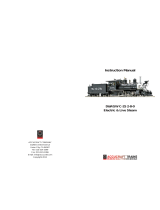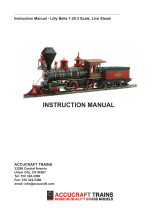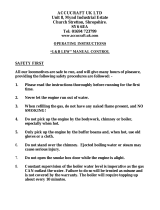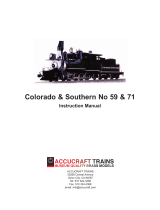C.P. Royal Hudson Live Steam - Alcohol Fired
7
that you’ll have to stay with the engine
through the run if you want to change
its speed or direction.
If you have a suitable track, the
engine can be left to run on its own
at a steady speed. Keep your eye on
the water glass. With practice and
good weather, steady runs of an hour
or more are not uncommon for this
engine.
Axle Pump:
This locomotive is equipped with an
axle pump and bypass valve. The
pump moves water from the tender
to a check valve on the locomotive.
The bypass valve is located on the
right side of the locomotive under the
cab. When the bypass valve is com-
pletely shut, water is pumped into the
locomotive. When the bypass valve is
open, the pump will re-circulate water
back into the tender. With careful
adjustment of this valve, the engine
will always have enough water to
keep running for long periods of time
until the tender water tank needs to be
refilled. The tender is also equipped
with the hand pump, which needs to
be used to prime the axle pump. Only
two or three strokes are necessary to
prime the pump.
Shutting down:
To shut the engine down, simply close
the Fuel valve and use your CO2 tire
inflator to extinguish the fire.
Make sure the fire is completely out
before turning off the steam blower if
engine is standing still. This will mini-
mize the chance of the paint getting
scorched from any fire still burning in
the firebox that is not vented!
After the fire is out at the end of the
run, open the blow down valve and
leave it open. This will relieve the
boiler of what little pressure remains
Because of the size of this engine,
blowing down could take several min-
utes.
After a day’s operation in the garden,
you’ll probably find that your engine
has a coating of oil all over it. This
is steam-cylinder oil that has been
exhausted from the stack. A simple
wipe down with a dry cloth is all that’s
necessary to restore the engine to
pristine condition.
This is best done while the engine is
still warm. Wipe any grit and excess
oil from the wheels and running.
C.P. Royal Hudson Live Steam - Alcohol Fired
4
Preparing for operation:
1. Oil all external moving parts
of the engine and tender with a high
grade, lightweight machine oil like 3-in-
1. Don’t forget the wheel bearings in
the pilot and trailing trucks, as well as
those in the tender. Don’t over-oil; a
tiny drop will do the job.
2. Place the engine and tender
on the track and couple them together.
The drawbar between the units has
two holes. For tighter curves, use the
rear hole. For wide-radius curves, the
engine and tender can be coupled
more closely together, using the front
hole. Then connect the water feed,
fuel and water return lines.
3. The displacement lubricator is
disguised as an air tank under the left
hand running board. This lubricator
ensures the cylinders and valves
are properly lubricated inside. As
the steam passes through it, a small
amount will condense into water. This
water will sink to the bottom of the
lubricator, forcing a similar quantity of
oil into the steam line and thus to the
cylinders.
Remove the lubricator cap and draw
out any water from the previous run
with a syringe. Use only proper steam
cylinder oil. Fill the lubricator, but leave
a small air space between the oil and
the cap.
4. Fill the tender with water.
Open the blower valve a little and
pump water into the boiler. Fill the
boiler until the water reaches the top
of the glass.
This is a BIG locomotive and it will
take a lot of water. Do not overfill the
boiler; there needs to be room above
the water for steam to form.
























